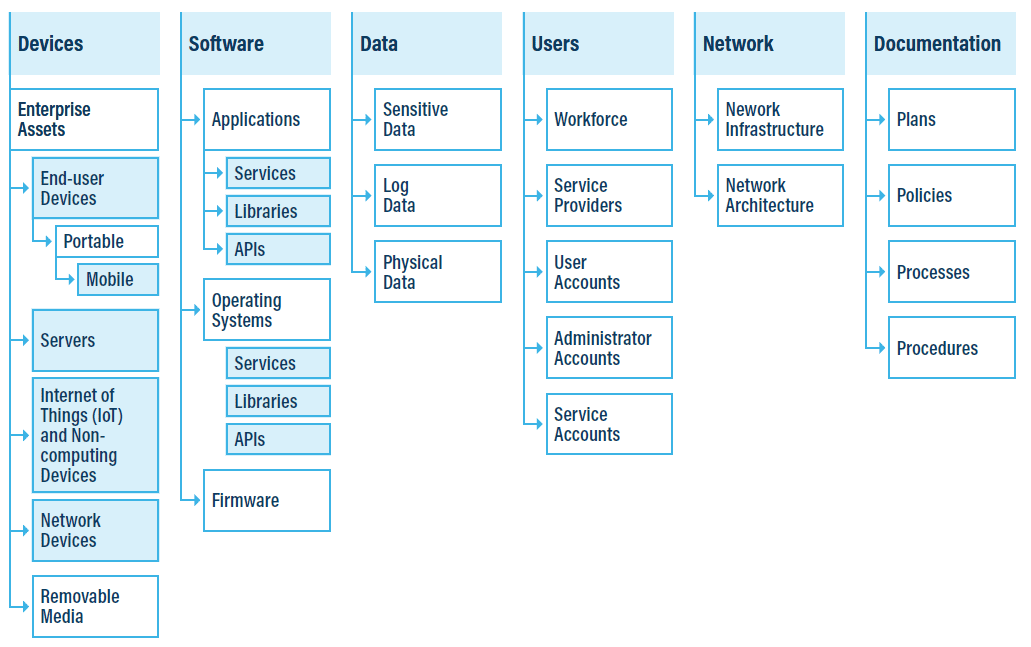CIS 18
Overview
The CIS Critical Security Controls (CIS 18) are a prioritized set of CIS Safeguards to mitigate the most common cyber-attacks against systems and networks.
The CDM approach
The CIS 18 controls are meant to be a highly efficient set of defensive actions, and not just another listing of good things to do. How did they select the controls then?! ![]() The answer relies on a data-driven approach: the Community Defense Model (CDM). The CDM experts identified the top 5 attacks from data sources, such as the Verizon DBIR and the ENISA Threat Landscape reports:
The answer relies on a data-driven approach: the Community Defense Model (CDM). The CDM experts identified the top 5 attacks from data sources, such as the Verizon DBIR and the ENISA Threat Landscape reports:
- Malware
- Ransomware

- Web Application Hacking
- Insider and privilege misuse

- Targeted intrusions
Then they identified the attack patterns used in each attack type, as modelled in the MITRE ATT&CK knowledge base. Finally, they identified the coverage of these techniques by the CIS 18 safeguards.
Note: The IG1 safeguards protects against the top five attack types, and covers 77% of the MITRE ATT&CK sub-techniques!
The CIS 18 spirit
We can find dozens of lists of efficient security recommendations. The real value of the CIS 18 Controls is the feedback from cybersecurity experts. How can I get trained? ![]() How others have implemented these controls? Is there a tool available? CIS 18 provides mappings to other risk management frameworks (NIST CSF, ISO 27001…) and regulations (PCI DSS, HIPAA…). CIS also includes the CIS Benchmarks, with security baselines for cloud providers, OS, software… Finally, CIS offers a Self-Assessment Tool (CIS CSAT), but you got to be a CIS member to read it!
How others have implemented these controls? Is there a tool available? CIS 18 provides mappings to other risk management frameworks (NIST CSF, ISO 27001…) and regulations (PCI DSS, HIPAA…). CIS also includes the CIS Benchmarks, with security baselines for cloud providers, OS, software… Finally, CIS offers a Self-Assessment Tool (CIS CSAT), but you got to be a CIS member to read it! ![]()
Implementation Groups
The CDM answers to the question “How effective are my controls against the most prevalent current attacks?”. The Implementation Groups IGs answer to the question “What shall I do first?”. ![]() The CIS 18 controls are built around the notion of Implementation Groups (CIS 18 IGs) to prioritize implementation. It helps companies to determine the actions that they shall prioritize:
The CIS 18 controls are built around the notion of Implementation Groups (CIS 18 IGs) to prioritize implementation. It helps companies to determine the actions that they shall prioritize:
-
IG1 for enterprises with limited IT and cybersecurity expertise

- IG2 for enterprises that employ individuals responsible for managing and protecting IT infrastructure
-
IG3 for enterprises that employ many cybersecurity experts specialized in the different facets of cybersecurity.

CIS 18 Controls
The CIS 18 contains 18 Security Controls:
- Control 1: Inventory and Control of Enterprise Assets
- Control 2: Inventory and Control of Software Assets
-
Control 3: Data Protection

- Control 4: Secure Configuration of Enterprise Assets and Software
- Control 5: Account Management
- Control 6: Access Control Management
- Control 7: Continuous Vulnerability Management
-
Control 8: Audit Log Management

-
Control 9: Email and Web Browser Protections

- Control 10: Malware Defenses
- Control 11: Data Recovery
- Control 12: Network Infrastructure Management
-
Control 13: Network Monitoring and Defense

- Control 14: Security Awareness and Skills Training
- Control 15: Service Provider Management
- Control 16: Application Software Security
- Control 17: Incident Response Management
-
Control 18: Penetration Testing

Note: This article is based on CIS 18 v8.1. No doubt a new version will be available as you read this. ![]()
Each control is made up of multiple safeguards. And each safeguard is mapped with:
- An asset type applicable to the safeguard
- A security function as identified in the NIST CSF
- An Implementation Group
Here is an extract for reference!

Asset types
CIS 18 provides a modelling of the different types of assets used in a company. It’s a gold mine! ![]()

Note: Based on original learning material from CIS 18. The CIS 18 licence is available here.